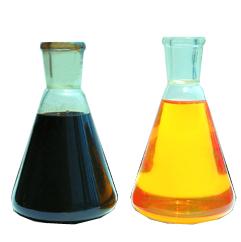Waste Oil Distillation Machine is the most effective process for used oil recycling, the engine oil treatment machine is to refine waste oil in a batch process. Waste lube oil after pre-treatment will be pumped into a distillation kettle under a vacuum. As the temperature in the kettle rises, various cuts are liberated and rise as vapors, to be condensed in a condenser. The condenser, along with the heating kettle, is maintained under a vacuum by a vacuum pumping system. The condensed products are available as different products corresponding to various kettle temperatures.
There are two ways to manage waste oil, the first is to recycle it into the base oil and the second is to add it into the fuel. The process of re-refining used motor oil is easier than refining crude oil. About 85-90% of the liquid in the waste oil is similar to diesel, which can meet the specification of 15# diesel.
Our waste oil distillation machine can carry out pyrolysis distillation of waste oil. According to the distillation temperature range of different fractions, 85-93% yellow base oil can be obtained. 50-160℃ is the gasoline fraction range, and 160-410℃ is the diesel fraction range. After cracking and cooling, about 2-5%% liquid is gasoline. About 85-90% of the liquid in the waste oil is similar to diesel, which can meet the specification of 15# diesel. They’re able to be used as industrial or civil-use fuel, even power-driven fuel. Waste motor oil is a small part of diesel in the refining industry. Motor oil and diesel belong to the same molecular weight of different petroleum series, so diesel production is very feasible.

Working Process of the Waste Oil Distillation Machine:
The working process for the waste oil distillation machine is to pump the waste oil into the distillation kettle, the heating system will start the stirring device. Gasoline components and water in the used oil can be distilled out when the temperature reaches 50 ℃-100℃. When the temperature reaches 160 ℃-260℃, after efficient catalytic and cracking, the light and heavy components will convert to diesel from vapor. Finally, we filter all collected diesel oil liquid, then we can get high-quality finished diesel oil.

Features:
- Waste oil distillation machines can produce waste oil into diesel oil at a low cost. The machine costs about $5- $6 to recycle a ton of waste oil.
- The machine is easy to operate and has a low running cost. It needs only 1-2 workers to operate the machine.
- The equipment can recycle all kinds of waste oil such as black diesel, used engine oil, used rubber oil, and waste plastic oil to diesel fuel. The cracked oil can be used as industrial or civil-use fuel, even power-driven fuel.
- The entire production process is environmentally protected without any smoke and odor.
- It is equipped with an efficient gas heating system and adopts hot air heating technology. It can heat fuel oil, natural gas, etc. The equipment is not only safe but also more efficient in production and processing. The exhaust gas from the distillation process will be burned in the distillation chamber, generating a lot of energy and saving resources.
- It has the quality of a high recovery rate. The highest recovery rate can reach 93-95%. You can get 2-5% gasoline, and 85-90% diesel.
Of course, as a professional manufacturer of waste oil recycling machines, we provide different types of waste oil recycling products according to different needs. Our waste oil recycling machine is made of hard materials, and the quality can be very well guaranteed. yangjiang is committed to new product research and development, dedicated to providing you with the highest cost-effective, high-quality products and meticulous after-sales service! Now we are researching a new Solvent extracting technology, which can refine base oil, black diesel,acid-refined oil, vacuum side streams oil, and clay filtration oil, etc. to oil like watercolor, the water base oil can match API II oil standard. we are committed to protecting the environment, through the recovery and re-refining of used oil into pure base oil. Help users to cut maintenance costs greatly, extend equipment life, and significantly reduce waste oil disposal problems.


